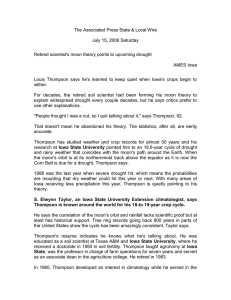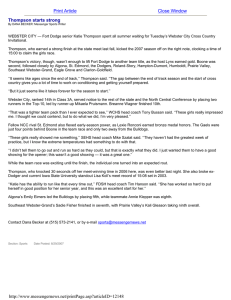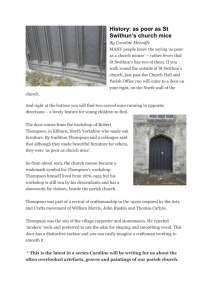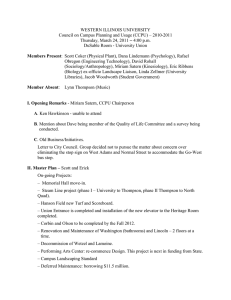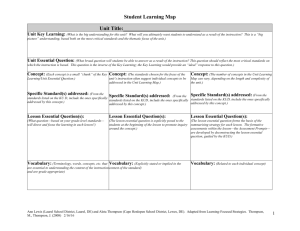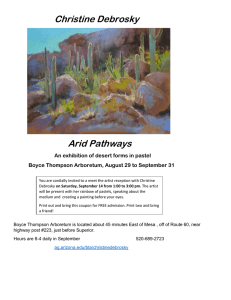Des Moines Register 07-09-06 Do lunar cycles cause droughts?
advertisement
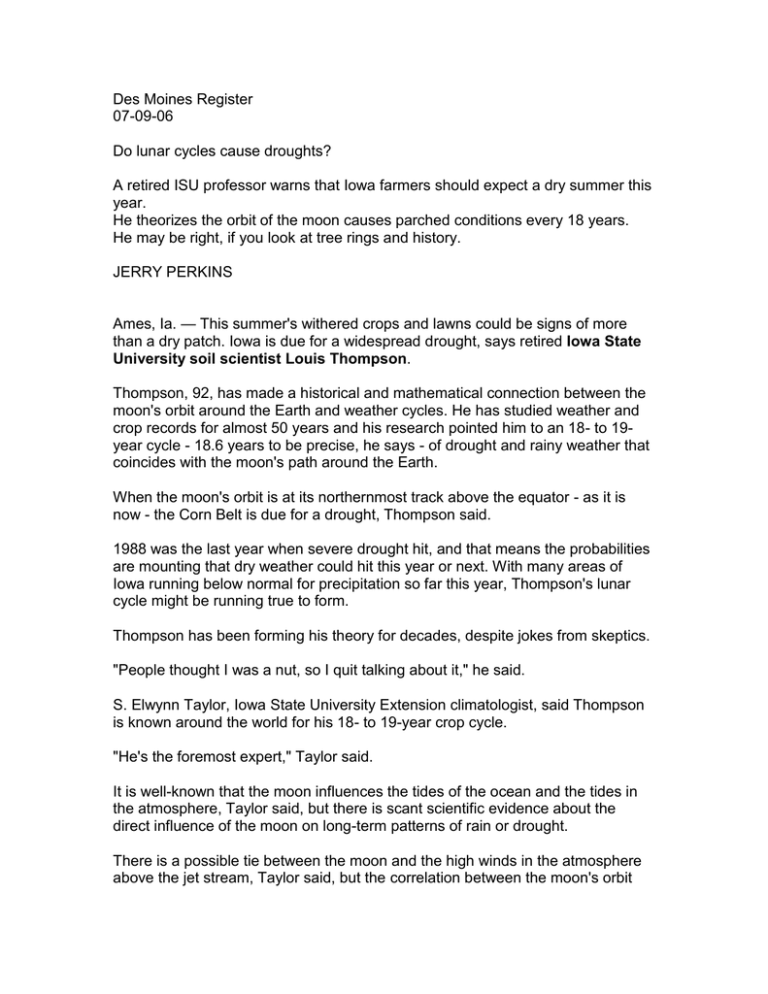
Des Moines Register 07-09-06 Do lunar cycles cause droughts? A retired ISU professor warns that Iowa farmers should expect a dry summer this year. He theorizes the orbit of the moon causes parched conditions every 18 years. He may be right, if you look at tree rings and history. JERRY PERKINS Ames, Ia. — This summer's withered crops and lawns could be signs of more than a dry patch. Iowa is due for a widespread drought, says retired Iowa State University soil scientist Louis Thompson. Thompson, 92, has made a historical and mathematical connection between the moon's orbit around the Earth and weather cycles. He has studied weather and crop records for almost 50 years and his research pointed him to an 18- to 19year cycle - 18.6 years to be precise, he says - of drought and rainy weather that coincides with the moon's path around the Earth. When the moon's orbit is at its northernmost track above the equator - as it is now - the Corn Belt is due for a drought, Thompson said. 1988 was the last year when severe drought hit, and that means the probabilities are mounting that dry weather could hit this year or next. With many areas of Iowa running below normal for precipitation so far this year, Thompson's lunar cycle might be running true to form. Thompson has been forming his theory for decades, despite jokes from skeptics. "People thought I was a nut, so I quit talking about it," he said. S. Elwynn Taylor, Iowa State University Extension climatologist, said Thompson is known around the world for his 18- to 19-year crop cycle. "He's the foremost expert," Taylor said. It is well-known that the moon influences the tides of the ocean and the tides in the atmosphere, Taylor said, but there is scant scientific evidence about the direct influence of the moon on long-term patterns of rain or drought. There is a possible tie between the moon and the high winds in the atmosphere above the jet stream, Taylor said, but the correlation between the moon's orbit around the Earth and a wet and dry cycle of 18.6 years is mostly historical. Tree ring records going back 800 years in parts of the United States show that the 18- to 19-year cycle has been amazingly consistent during that long time period, Taylor said. Flood tides on the ocean also are on an 18.6-year cycle, Taylor said. "That's well-known by coastal residents," he said. Charles Nelson, professor of physics and astronomy at Drake University, said he had never heard of Thompson's lunar weather cycle. However, said Nelson, there is a cycle of lunar and solar eclipses that repeats itself every 18.6 years, just like the lunar crop cycle suggested by Thompson. "There are things we can observe that we cannot explain," Nelson said. Thompson is no starry-eyed moon-child aching for the Age of Aquarius. He was educated as a soil scientist at Texas A & M and Iowa State University, where he received a doctorate in 1950 in soil fertility. Thompson taught agronomy at Iowa State, was the professor in charge of farm operations for seven years and served as an associate dean in the agriculture college. He retired in 1983. In 1960, Thompson developed an interest in climatology while he served in the U.S. Army Reserves. "I proposed that I could develop a method to predict crop yields from weather data," Thompson recalled. "I was told it couldn't be done, but I did it in a year." Digging into some old records going back to 1810, Thompson found there was an 18- to 19-year cycle between drought years. That lined up with the lunar cycle, Thompson found, as the moon's orbit moved north and south on its travels around the Earth. Decades of the 1930s, 1950s and 1970s were mostly dry, Thompson noted. The 1920s, 1940s and 1960s were generally wetter. Although Thompson became very well-known over the years because of his lunar weather cycle, he wears his title of foremost expert with a bit of discomfort. After more than 20 years, Thompson still feels the sting of a crack made by former U.S. Secretary of Agriculture Earl Butz, who asked Thompson if he had checked his moon correlations with Nancy Reagan's astrologer. Never mind that Butz, who turned 96 on Monday, was forced to resign as secretary of agriculture after he told a racially insensitive, off-color joke. Nor does it matter to Thompson that Butz spent time in federal prison for tax evasion. "When Butz made his crack, I knew right away I shouldn't talk about it," Thompson said. Thompson has spoken about other weather phenomena over the years, including the impact of the warming or cooling of the eastern Pacific Ocean currently known as El Niño-La Niña. Those forces trump the moon's impact on climate and drought, Thompson says, and that's why a drought may or may not happen anytime soon. El Niño conditions occur when warmer water develops off the coast of Peru and heads north on the Pacific current. El Niño tends to produce better crops in the Corn Belt. La Niña, caused when Pacific Ocean waters cool, tends to bring less rainfall to the Midwest and results in lower crop yields. Iowa State's Taylor said that after months of neutral signals, the scale is tipping toward El Niño conditions. "That's nothing but good news for us," Taylor said. "It means it won't be oppressively hot." If this El Niño develops and trumps the moon cycle, as Thompson says it might, there's always next year. test
